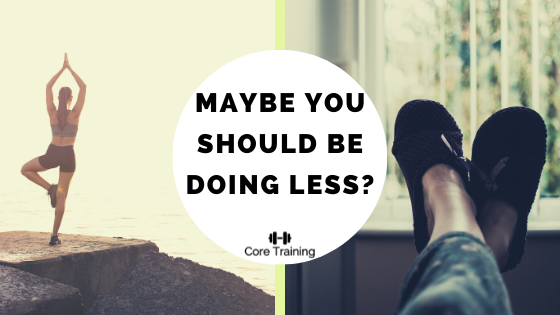Maybe you should be doing less?
You might find the title of this week’s blog strange, especially coming from a personal trainer: we’re usually the ones telling people to push themselves, do more and work harder, no? While that may still be the stereotype, it’s not actually true of any good trainers. In fitness, just as in life, more is not always better. In fact, after a certain point, ‘doing more’ can actually be more detrimental than beneficial. So today I’m going to explain why, in certain circumstances, you might get better outcomes from doing less, not more.
Now, if you are someone who currently isn’t exercising regularly, is inactive, or doesn’t have a well-rounded diet, then what you’re about to read probably doesn’t apply to you. For many people it is true that they should be trying to do ‘more’ and not ‘less’. However, there are plenty of people who are already active, exercising regularly and eating nutritiously who believe that they still need to do more in order to achieve the result they want, or that their lack of results is due to not doing enough. In some cases, this line of thinking would actually be false, and potentially damaging to them and their progress.
When it comes to training, we want to stay somewhere between our ‘MED’ (minimum effective dose), and our ‘MRV’ (maximum recoverable volume) in order to maximise our progress. In straightforward terms, we want to make sure we stay between doing the least amount possible while still progressing, and the most exercise we can do and still adequately recover from. In order to do this, we need to take into account the frequency, duration and intensity of the training we are doing on a regular basis. You might also be thinking that the aim should be to get as close to our MRV as possible, but that isn’t actually the case. Our MRV is essentially our ‘limit’, so the closer we get to that point, the less chance there is that we recover efficiently. So, to circle back to the title of this blog, maybe it’s actually a good idea to be doing less, not more…
We actually don’t ‘progress’ during training or exercise sessions - the sessions themselves just serve as the stimulus necessary for us to make progress, which happens in-between sessions, when we are recovering. So the closer we push to the limits of what we can recover from, the harder it is for us to recover, and by extension, progress. If you don’t have a time-oriented goal, and you have other life commitment and stressors (like nearly all of us), then I would personally advise staying in a more comfortable zone, where you find it relatively easy to fully recover. You will still make significant progress, maybe just not at the fastest rate possible, but you will still find it possible to meet all of your other life commitments without being exhausted. This also reduces the risk of ‘overtraining’ - something I wrote about recently in a blog you can find here.
So, if you aren’t seeing the progress or results you want in (or out) of the gym, rather than immediately assuming you need to ‘do more’ or ‘push harder’ - have a realistic think about how hard you already are working. Is it realistic for you to add in more exercise without making a compromise somewhere else in your life? Are you already finding it hard to recover from what you are already doing? Are you finding yourself enjoying your training less in recent months? If the answer to any of these questions is ‘yes’, then I would suggest the answer may actually be to reduce the amount of exercise you are doing, not increase it.


